Current Research
Goodrich Passenger Steamer Atlanta - Field School
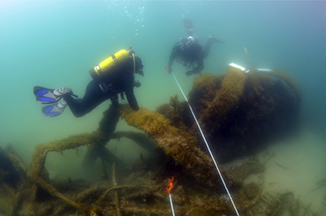
The steamer Atlanta was built in 1891 at the Cleveland Dry Dock Company for the Goodrich Transportation Company. The ship measured 200.10 ft. in length, with a 32 ft. beam and 13.60 ft. depth of hold, and transported passengers and package freight on Lake Michigan during her service career. At 11:15 a.m. on 18 March 1906, Atlanta departed Sheboygan enroute to Milwaukee carrying 65 passengers and a cargo of mostly porcelain, enamelware, metalware, leather, and wooden furniture. Around noon, 14 miles south of Sheboygan, crewmen discovered a fire in the hold of the vessel. The fire was fought with precision by the well-practiced crew, but to no avail. The new automatic sprinklers and fire apparatus, tested only six days prior, could not stop the blaze.
Survey of the Tubal Cain
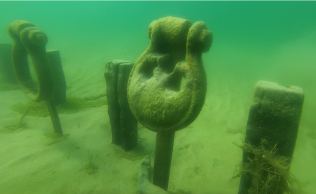
The results of this 2016 survey greatly added to continuing research into hull variations within sailing candlers that have been documented in Wisconsin waters, including the Walter B. Allen, Floretta, America, and Daniel Lyons. Canallers were a unique vessel type developed on the Great Lakes to transit the Welland Canal, the canal that bypasses Niagara Falls and connects Lakes Erie and Ontario. Vessel were constructed with unique features to allow the ships into the locks, while carrying the maximum amount of cargo with only inches to spare.
Survey of the Grace A. Channon
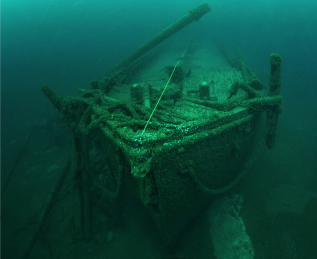
On the night of August 2, 1877, Grace A. Channon was carrying a cargo of coal from Buffalo bound for Chicago when the four-year-old schooner plunged to the bottom of Lake Michigan within five minutes of being struck by the propeller Favorite. Her co-owner, Henry L. Graham and his two young sons, Harry and Alexander, were aboard taking passage from Buffalo to Chicago by water. Seven-year-old Alexander became separated from his father and was sucked under as the ship sank in 180 feet of water 16 miles southeast of Milwaukee. The results of this survey have contributed to our understanding of the construction, adaptations and use of sailing canallers adding to knowledge gained from Daniel Lyons, Walter B. Allen, Floretta, America and others.
Evaluation of Remains of a Sunken Vessel Believed to be the H.L. Whitman
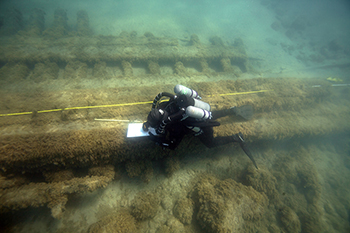
S.S. Senator ROV Documentation

Data on the shipwreck and current observations were collected by remotely operated vehicle (ROV) and multi beam sonar imagery provided by Crossmon Consulting of Hermantown, Minnesota in December of 2015 which allowed for listing of the site to the National Register of Historic Places.
Survey of the Car Ferry Milwaukee
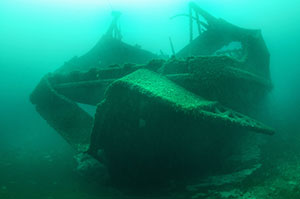
Apostle Islands Brownstone Quarry Docks Survey
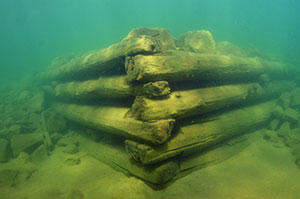
National Register of Historic Places Boundary Expansions

Survey of the Schooner Pathfinder

The schooner Pathfinder is a 635-ton, three-masted schooner built in Detroit, Michigan, by Campbell, Owen & Company, in 1869. She sailed in the Great Lakes iron ore trade until she was caught in a gale north of Two Rivers Light in November of 1886, and was considered to be a total loss because she sank into a "bed of quicksand" just off shore of Two Creeks. Today the remains of the vessel lie in 15 feet of water, with most of her lower section intact, including a large portion of her iron ore cargo. The lack of zebra and quagga mussels on parts of the vessel's hull indicate that until recently, most of the vessel was covered by sand. Archaeological investigations have discovered multiple areas in which the vessel was "strengthened" and repaired following multiple collisions. Although in shallow water, the vessel maintains excellent integrity.
Survey of the Scow-schooner Success

The Success is a 151-ton, two-masted scow schooner built in Manitowoc, Wisconsin, by Julius Johnson, in 1875. She sailed in the Lake Michigan lumber trade until she was caught in a storm while loading wood in Whitefish Bay and was pushed aground on the beach in November of 1896. Today the remains of the vessel lie in 8 feet of water, with most of her lower section intact, just off shore. The lack of zebra and quagga mussels on the vessel's hull indicate that she was only recently uncovered from the sand. Archaeological investigations indicate that the Success was a transitional vessel, implementing building techniques seen in San Francisco scow construction and no where else in the Great Lakes. Though in shallow water, many of the vessel's sailing implements remain on the site, including wire rigging, dead eyes, the bilge pump, and centerboard.
This documentation adds to the information already collected on historic scow schooners in Wisconsin waters, the most recent of which was the survey of the Silver Lake. The Silver Lake is a 105-ton, two-masted scow schooner that was built in Little Point Sable, Michigan, in 1889. She sailed in the Lake Michigan lumber trade until she collided with the Pere Marquette on 28 May 1900. Today, she lies upright and intact in 210 feet of water northeast of Sheboygan. Her hull is fractured from the collision, but her foremast remains standing with a rigged yard.
Survey of the Schooner Hanover
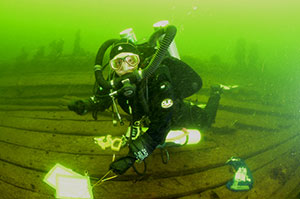
Survey of the Lady Ellen

The results of this 2011 survey greatly added to the growing list of scow schooners that have been documented in Wisconsin waters, including the Ocean Wave, Iris, Tennie and Laura, and Daniel Hayes. Although the scow schooner was vital to many early Lake Michigan communities, this vessel class is poorly documented in the historic record and their construction and use are poorly understood today. The archaeological surveys of the Silver Lake and Lady Ellen will greatly contribute our knowledge and understanding of this poorly-understood vessel class and its role in shaping Wisconsin.
